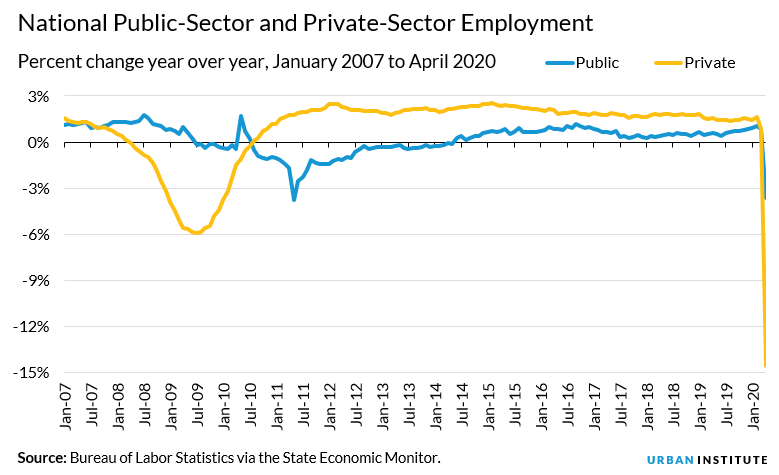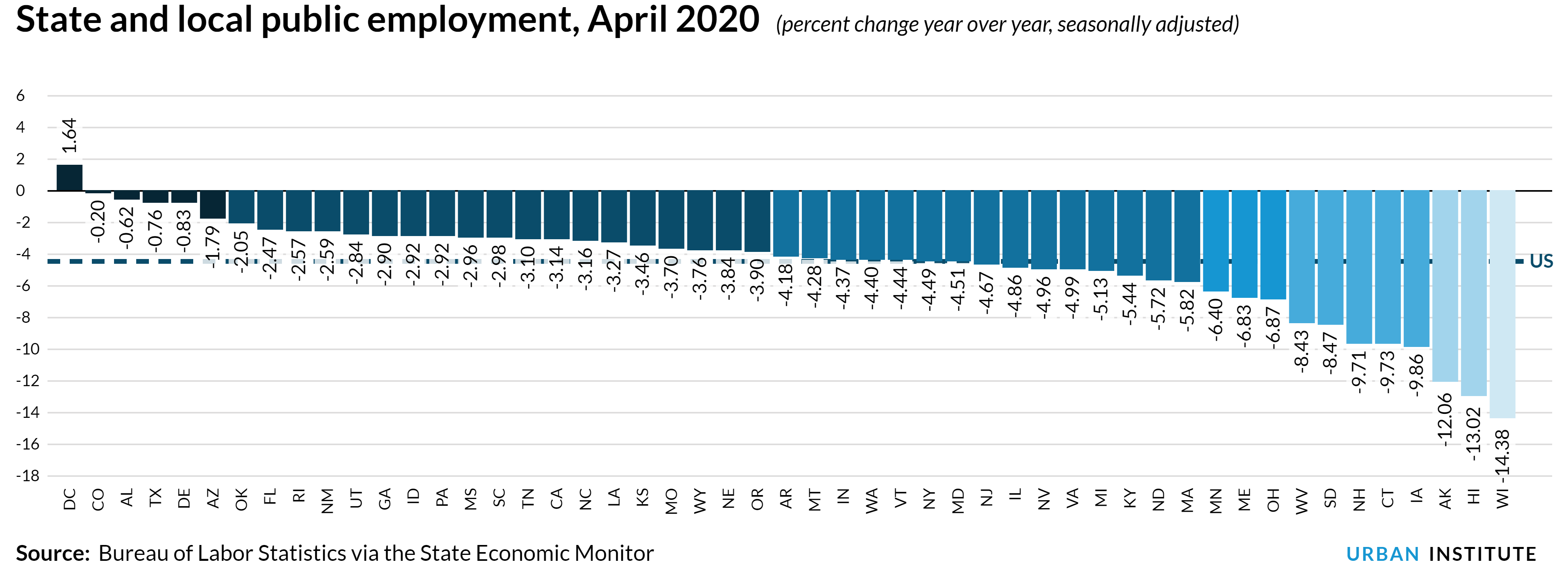
<p>Maria Mora came to find information about her claim but found the California State Employment Development Department was closed due to coronavirus concerns on Thursday, May 14, 2020 in Canoga Park, CA. (Brian van der Brug / Los Angeles Times via Getty Images)</p>
In April 2020, unemployment rates increased in all 50 states and the District of Columbia and surpassed 20 percent in three states: Hawaii, Michigan, and Nevada. Between February and April, total employment declined the most in Michigan (–23 percent), Vermont (–21 percent), and New York (–20 percent).
These trends reflect the impact of the virus, state policy actions, and behavioral responses, in addition to the economic makeup of each state. For example, Nevada experienced severe job losses (a 19 percent decline in employment between February and April) despite relatively few COVID-19 cases because a quarter of its jobs are in the heavily affected leisure and hospitality sector.
One economic sector important to all states—and where services are arguably needed more than ever—also saw severe losses: the public sector. State and local government activity accounts for roughly 8 percent of US gross domestic product (GDP) and includes spending on key goods and services, such as public education, public health services, transportation, and infrastructure. This is why many are calling on Congress to send state and local governments additional federal stimulus relief.
Where state and local government employment is declining
At the beginning of a recession, public-sector jobs are typically more stable than private-sector jobs. During the Great Recession, private-sector employment began to decrease in early 2008, declining 3.2 percent from December 2007 to December 2008, while the public-sector actually gained jobs early on, before beginning to decline in mid-2010.

But in this recession, governments are already cutting back on spending by reducing workers’ hours, furloughing staff, and resorting to layoffs.
Before COVID-19, state and local governments employed nearly 20 million people. According to the April jobs report (PDF), nearly 1 million state and local government jobs were lost last month alone, and in all 50 states, state and local public employment has decreased since last April.
Overall, since February, state and local public-sector job losses ranged from –2 percent in Alabama to –14 percent in Wisconsin. Education in particular has faced grave losses; between February and April, Wisconsin lost 1 in 5 state and local public education jobs. These jobs are vanishing in the face of falling revenues (PDF) and pressures on public spending as state and local governments confront year-end balanced budget requirements.

This is a big deal. Although the share of a state’s GDP generated by state and local government activity varies from state to state, it is an important economic industry, contributing at least 5 percent of each state’s GDP.
And the effects of COVID-19 are anything but equal. Black workers are overrepresented in many essential government jobs, and Black and Latino households have borne a disproportionately high burden of COVID-19 cases and deaths in most states, including Louisiana and New York.
Other big industries are experiencing declines, too
Other sectors have also experienced severe losses, including private education and health care services, which lost 2.5 million jobs in April. These declines are driven by nationwide closings of family and child care services, private schools, and nonessential medical offices.
States that rely heavily on tourism and leisure have seen dramatic declines in employment. In Nevada and Hawaii—the only states where more than 10 percent of the GDP comes from the arts, entertainment, food, and hotel industries—unemployment surpassed 20 percent in April, the highest ever recorded by the US Bureau of Labor Statistics (since 1976).
Losses in all these sectors contributed to declines in private employment in all 50 states and the District of Columbia, with Michigan (–26 percent) facing the worst job losses since February.
Recovery amid uncertainty
Many states are currently reopening despite economic and public health uncertainties. We can hope jobs will return as economic activity increases (though early evidence suggests recovery could be slow). However, over the last few weeks, state and local governments have ricocheted from expecting revenue growth to trying to understand how terrible the shortfalls will be.
The well-being of public-sector jobs is critical to a functioning US economy. As the economy reopens, we will have a need for teachers, bus and train operators, maintenance workers, judges and court clerks, social workers, and new public health positions to help test and trace infected residents. More federal funding will be crucial, and Congress may want to consider targeting support for state and local governments.
We need not look too far back in history to understand the importance of timely federal stimulus for states and localities. At the height of the Great Recession, the American Recovery and Reinvestment Act helped temporarily save hundreds of thousands of public-sector jobs, primarily those of teachers in school districts facing budget shortfalls.
Flexible and formula-driven aid would help stem the flow of jobs out of this crucial economic sector and contribute to the safe reopening of the rest of the economy.
Let’s build a future where everyone, everywhere has the opportunity and power to thrive
Urban is more determined than ever to partner with changemakers to unlock opportunities that give people across the country a fair shot at reaching their fullest potential. Invest in Urban to power this type of work.